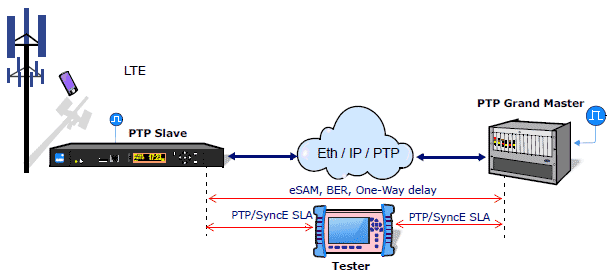|
PTP and LTE mobile networks
PTP master-slave architectures demand high precision and long term stability. Then good installation and maintenance tools are needed, particularly if you consider that each network element has it's own timing requirements (i.e. in a Grand Master max|TE| must be better than 100ns whilst at the Client site is 1.1us). Have a look to the most advanced family of field testers in terms of flexibility, accuracy and resolution.
- Built-in Rubidium clock: 1.5us @ 24h
- Warm up 300 seg, locking time: 10 min
- Master & Slave emulation
- ESMC and SSM full support
- MTIE, TDEV, Wander generation, FPP test
- Time Error (TE), max|TE|, constant/dynamic TE
How to verify a PTP Slave clock

Only 10 minutes of training with GPS are enough for time locking and then you can measure phase and frequency at 1pps and GbE interfaces.
To get the highest accuracy measure during 3h and then compare the results to find out if the slave clock is working well (see two previous figures).
How to Qualify the Transport Layer

This should be the first step before installing PTP. The Transport Layer Qualification must be qualified by means of test suites such as RFC2544 and eSAM to assure a good infrastructure. You can also execute these tests with ALBEDO testers and appliances.
How to aprove a Synchronisation network

Using a couple of testers configured as Master and Slave measure Packet Delay (PD), Delay Variation (PDV) and One Way Delay (OWD). This set of results obtained at different points of the network will be useful to get a broadview of the quality of the Synchronisation network.
Let's go. Check the Base Station

Noise and Asymmetry are typical Phase impairments that may suffer base station clocks. To prevent and eventually get rid of these events the first step is to measure this impact by means of two key parameters: Dynamic and Constant Time Error (dTE and cTE).
Would your network pass the PTP Conformity?

A complete study about PTP network conformity could be achieved replacing the Grand Master by one ALBEDO tester that can easily change
the time references from GPS to BITS, SyncE, T1/E1, etc. It will also be very useful to observe the different results measured at the far-end when changing the Grand Master configuration to generate a PTP stream. For instance, select different PTP packets/sec, 1-step or 2-step synchronisation, or the time scale
from arbitrary to TAI, etc. and then analyse the results.
Good Synchronisation practices

One of the most advanced test that only ALBEDO testers can do is the characterisation of the PTP network in terms of frequency and phase tolerance under several traffic conditions.
Ether.Genius can generate PTP flows and simultaneously dummy Ethernet traffic to stress the whole network while PTP is running. At the far-end the second tester is measuring and eventually obtaining different results for each traffic level. The same test can be performed at the base station site.


Dear Customer,
Synchronisation has always been a fundamental service for mobile networks. It allows to manage the mobile phones,
or to get perfect access to up/down time-slots. Moreover, the new MBMS service supports broadcast delivery to a large number of users requires a single frequency
across the whole network using a synchronous LTE architecture.
This is why ALBEDO field testing tools are required: to control how the Time service is delivered across the whole network.
ALBEDO: powerful yet cost effective and affordable solutions.
Kind Regards,
 Marketing & Sales Director
Marketing & Sales Director
|

